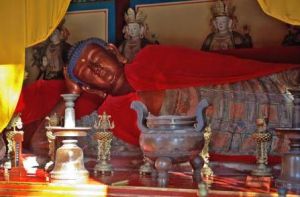Wofo Temple
Wofo Temple (Temple of the Recumbent Buddha) is also located at the slopes of the Western Hills, not far from the Fragrant Hills Park and the Temple of Azure Clouds.
The temple was first built in the 7th century in the Tang Dynasty, when it is believed that the temple already had a statue of a recumbent Buddha in sandlewood. The temple was renovated and expanded in different dynasties, and its name was changed time and again from the original name Doushuaisi, to Longevity Peace Hill Temple (Shou'anshansi), Great Filial Manifestation Temple (Dazhaoxiaosi), Great Celebration Temple (Hongqingsi), Eternal Peace Temple (Yong'ansi), and Universal Awakening Temple (Shifang Pujuesi) which it retains to the present day. In 1321, in the Yuan Dynasty, fifty tons of copper were used to cast an enormous statue of a recumbent Buddha which has been housed in the temple ever since. Because of the recumbent Buddha, the temple is popularly known as Temple of the Recumbent Buddha (Wofosi) and has become an attractive tourist spot.
The present recumbent Buddha weighs about 54 tons and is 5.2 m in length. The Buddha lies on his side, his legs stretched out, his left arm resting on his left thigh and his right arm bent to support his head. The figure is well-proportioned and the pose is easy and relaxed. Behind it is a row of his twelve disciples modeled in clay, each is 1.2 m high. This is a scene, according to tradition, when Sakyamuni was giving his last instructions to his disciples on his death bed. Along the east and west walls are cases of embroidered cloth shoes offered by the Qing emperors to the bare-footed Buddha.
The architecture of the temple is a very typical Buddhist temple structure, with a mountain gate, Davaraja Hall, the Hall of the Buddhas of the Three Ages and the Hall of the Recumbent Buddha, a two-storey hall for Buddhist scriptures and a pavilion on the Hill of Longevity and Peace behind the main buildings, overlooking the whole temple on the central axis, and side halls and covered corridors on the sides. West of the main temple court are a series of three pavilions, formerly for the use of the emperor. There is a rockery, a small pond spanned by a bridge, and a beautiful large square pond covered with lotus. The last of the pavilions is now a teahouse where visitors may take a rest and enjoy sipping tea made with spring water from the hills. On the other side of the temple court are dormitories for the monks.
The temple is also famous for its rare and beautiful trees, such as the avenue of ancient cypresses leading to the temple gate, sal trees brought from India, pines, ginkgos, locusts, wistaria, lilac and forsythia.
About half a kilometer northwest of the temple is the Cherry Valley (Yingtaogou), a small, attractive park winding up a hill in a natural woodland setting, with a hermit's cave and a clear stream. The water is extremely cool in summer and tastes sweet.
